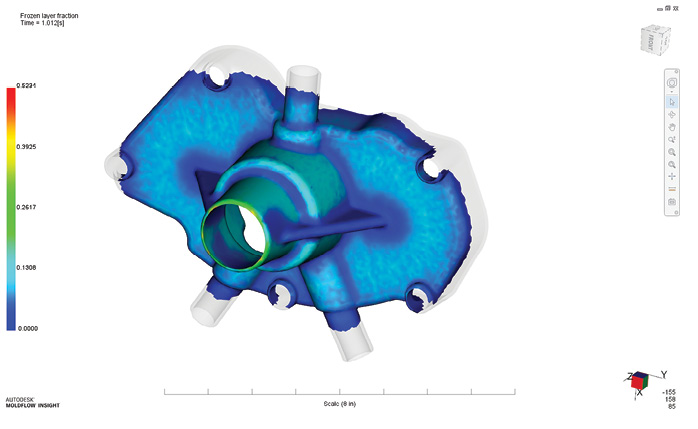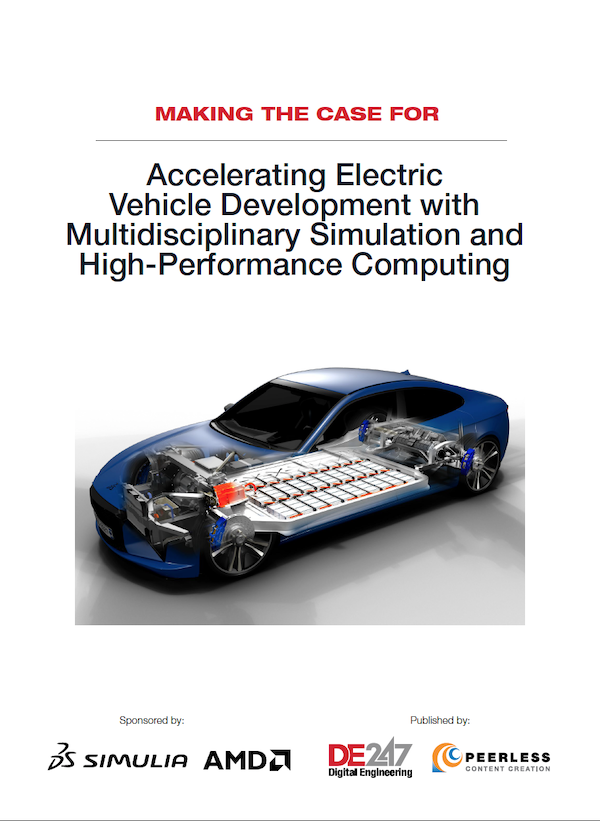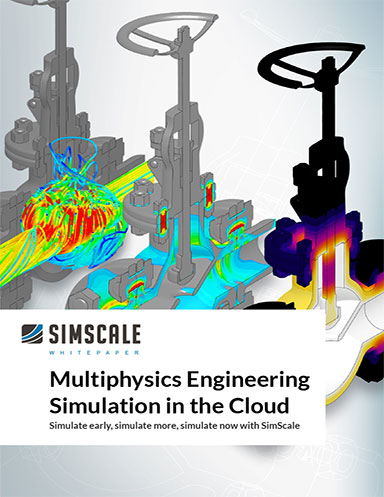Optional Multiphysics, Mandatory Multiphysics

Latest News
September 1, 2017
Suppose you’re simulating how an engine component expands in response to heat buildup during a car’s drive. If you use a simulation package that lets you simulate the component’s expansion (structural physics) and heat propagation (thermal physics) simultaneously, the job is indisputably multiphysics. But if, due to the limitation of the software or out of your own choice, you simulate the heat buildup inside the engine chamber first and then use the result as input to figure out the component’s expansion, is it multiphysics?
In the view of Chris Wolfe, lead product manager of multiphysics at ANSYS, “Multiphysics simulations happen whenever engineers need to understand the effects of multiple physics on real-world products. More specifically, any time data is shared between solvers from different traditional disciplines (computational fluid dynamics or CFD, finite element analysis or FEA, electromagnetics, etc.), an engineer is performing multiphysics simulation. In this context, both the sequential and simultaneous solving of multiple disciplines of physics are multiphysics simulations.”
Similarly, Nicolas Tillet, product portfolio manager, Dassault Systèmes SOLIDWORKS, says, “Multiphysics involves different types of physics. The simulation job can be sequential or simultaneous.”
Greg Fallon, vice president of simulation at Autodesk, says, “I don’t see the distinction whether you solve sequentially or simultaneously, because in the end, you’re dealing with various types of physics.”

IronCAD integrated the multiphysics solvers from AMPS Technologies, enabling IronCAD users to set up and run multiphysics analyses from the CAD modeling environment. Shown here is the multiphysics analysis of a microprocessor chip. Image courtesy of IronCAD.
Perhaps what’s more important is to identify the scenarios where multiphysics treatment is truly warranted. Whether it’s saline fluid flow inside a medical device or airflow around a race car, if you can get the answer you need by reducing the phenomenon to a simpler study, then setting it up and solving it as multiphysics is an excessive use of resources, both in hardware and in manpower.
Inseparable Physics, Isolatable Physics
How can you tell if something truly demands multiphysics? When is it acceptable to simulate the different physics sequentially? When is it important to compute them together? Partly, the wisdom comes from industry experience and engineering tenure, neither of which a software package can teach you.
Ted Lin, general manager of AMPS Technologies, says, “Most experienced users can tell right away if a problem needs multiphysics or not. For example, take the act of pouring hot water into a glass. If you want to figure out the point at which the glass will break due to hot water temperature, typically you don’t need to set it up as multiphysics, because the temperature’s effect on the expansion behavior in this kind of scenario is not crucial.”
But the same phenomenon under a slightly different environment may make multiphysics a must, not optional. “If it’s freezing outside, in other words, the temperature around the glass is extremely low, then the temperature gradients inside the glass and outside become important to study, because the glass will break a lot sooner,” Lin adds.


 Autodesk Moldflow, targeting the injection molding industry, is inherently multiphysics. The above Moldflow results show: the fill time (flow), frozen layer fraction (phase change), temperature (cavity and core) and von Mises stresses (core) of a water pump housing model and the mold assembly.Images courtesy of Autodesk.
Autodesk Moldflow, targeting the injection molding industry, is inherently multiphysics. The above Moldflow results show: the fill time (flow), frozen layer fraction (phase change), temperature (cavity and core) and von Mises stresses (core) of a water pump housing model and the mold assembly.Images courtesy of Autodesk.Take another example: the stresses on the side of a building due to strong winds. Technically, the scenario involves two types of physics: fluid flow (to compute the airflow) and structural (to account for the building’s surface). “In that case, even if the stresses are high, the associated deformation of the surface is minimal,” notes Bjorn Sjodin, vice president of product management, COMSOL. “So you may start the simulation in CFD, then use the result as input for your structural analysis. In some cases, it’s beneficial to run the physics sequentially.”
Wolfe points out: “Many times, solving the physics sequentially provides good enough information to guide the engineer toward a good solution. Sequential simulation is often easier for a team of analysts or engineers, with different areas of expertise and sometimes working across organizational silos.”
On the other hand, simulating the flow of hot plastic liquid into a mold would demand coupled multiphysics. Such a scenario is the specialty of Autodesk Moldflow, a software package that targets the injection molding industry. Fallon explains: “At first, the plastic is hot, but as it starts to cool down, the flow speed changes; it slows down. Then it starts solidifying. The problem involves thermal, fluid flow and phased changes. You just can’t separate the various types of physics involved. If you simulate it as viscous fluid flow inside the mold, your answer will be way off.”
 ANSYS AIM uses guided workflows to make multiphysics easier to set up and process. Image courtesy of ANSYS.
ANSYS AIM uses guided workflows to make multiphysics easier to set up and process. Image courtesy of ANSYS.Similarly, the deceptively simple design of the heating coil in a cooktop oven may demand multiphysics analysis, according to Lin. “The coil design hardly has any sharp corners. The turn angle has to be smooth to prevent overheating due to heat concentration in turn corners. To analyze it, you’d need electrical-thermal-structural simulation, all three running together,” he explains. “If you use a linear solution—in other words, if you solve one physics at a time and then put the answers together—you will not catch the critical peak conditions.”
Wolfe points out: “A smaller number of problems, mainly those involving highly deformable solids, very short timescales, and combinations thereof, have physical interactions that are so tightly woven together and dependent on each other that they require tightly integrated co-simulation—solving the physics together—to adequately capture the phenomena occurring. But these problems are often complex and expensive to run. Hence, they are used only when the benefits outweigh the costs.”
Build for Coupled Physics
When a problem does involve physics that are inseparably intertwined, software designed specifically for co-computation offers an advantage. COMSOL, which explicitly brands its software as COMSOL Multiphysics, is among them.
“In COMSOL’s software environment, different types of physics talk to each other, if you will,” says Sjodin. “If you have to merge two different software packages [for example, one for CFD, another for structural], then the engineers have to learn two programs (and) figure out the file import-export protocols, so it’s more complicated.”
AMPS, which licenses its technology for integration, stands for Advanced Multiphysics Simulation. “AMPS was developed from day one with multiphysics in mind,” Lin says. “It was initially developed to use in glass fiber manufacturing. We designed it to simultaneously compute stress, thermal, fluid and electromagnetics in a single code, solving them in a single execution cycle. Integrated multiphysics analysis approach becomes crucial when the Joule heat generation is very high, as the temperature dependency of electrical and thermal conductivity are usually reversed. In these cases, the decoupled approach will lead to false results, or it may not converge at all.”
Targeting the Designers
In 2015, IronCAD integrated AMPS Technologies’ solvers into its CAD package. IronCAD users can now set up and simulate multiphysics phenomena from the design and modeling environment.
“A lot of the things in multiphysics, and even in FEA, have always been a struggle for users,” says Cary O’Connor, vice president of marketing, IronCAD. “It’s difficult for people to run analysis on assemblies, because they need to understand how to set up the contacts between parts. IronCAD makes that process simple. You mesh the assembly as it is; IronCAD automatically builds these contacts, using the proper mesh types, and solves quickly using patented technology. It gives users a better overall user experience.”
CAD-integrated or CAD-embedded simulation tools are an offshoot of the simulation industry’s efforts to expand its reach. The high-end simulation tools developed for experts tend to present a steep learning curve for generalists and design engineers. Introducing simulation through a simpler interface nested inside a CAD program is one way to lower the barrier of entry. Examples of this can be seen in SOLIDWORKS Simulation, which is tightly integrated with SOLIDWORKS CAD software, and Autodesk Fusion, which delivers CAD modeling and simulation tools in a single environment.
“In SOLIDWORKS, we focus on the ease of use,” Tillet says. “It’s implemented in a way that’s easy to learn and use for all designers.”
Fallon reasons, “In the concept phase, you’re doing (a) quick design check to make intelligent decisions. The accuracy requirements in this are very different from what’s needed in the detailed design phase. Our tools in Autodesk Fusion and Autodesk Inventor are very much targeted at the designers in the conceptual phase.”
ANSYS attracts designers with ANSYS AIM, featuring guided workflows. “Multiphysics tools for designers need to speak the designer’s language, streamline the simulation process as much as possible and guide the designer through the necessary steps,” Wolfe says. “ANSYS AIM emphasizes ease of use and streamlined workflows that enable single discipline and multiphysics simulations for designers. UI (user interface) elements like guided workflows, built-in simulation guidance and customization capabilities make single physics and multiphysics simulation accessible to designers.”
Internal Apps
In COMSOL Multiphysics 5.1, COMSOL began offering the Application Builder, which allows users to publish complex simulation jobs as template-driven apps. The company also offers COMSOL Server, which allows users to host their apps for wider distribution. With this approach, COMSOL lets experts set up and produce complex simulation workflows that can be executed by generalists and designers with limited simulation knowledge.
Presently, the apps published are mostly proprietary apps for internal use within different companies. Apps available to the public in online marketplaces are still a rarity, for good reasons. “If a company publishes an app, that app typically encompasses the core company secrets, basically their most proprietary industry knowledge, so it’s highly unlikely they’ll distribute it publicly. They might publish it for their own partners, customers and vendors in a closed ecosystem,” Sjodin points out. “I believe we will start to see publicly available simulation apps emerging from academia. After all, they have an interest in spreading their knowledge.”
One example of emerging apps from academia is AweSim, an offshoot of the Ohio Supercomputer Center and its partners. Its offerings include a list of simulation apps, for purposes ranging from heatsink design analysis and fixed-wing unmanned aircraft performance prediction, to ship drag and trim study.
The IoT Effect
One reason the demand for multiphysics analysis might increase is the growing number of connected devices. With heat-generating electrical components tightly packaged inside, smartphones, smartwatches and wearables must balance the effects of several types of interdependent physics. It makes multiphysics simulation the only means to study them effectively.
“In high-frequency electromagnetics, the antenna or the oscillator’s performance is directly impacted by thermal conditions,” says Fallon. “The sensitivity of the antenna becomes deeply intertwined with the thermal conditions.”
“The miniaturized devices put serious constraints on the internal components,” says Sjodin. “The deformation of components, changes in temperature and electromagnetic fields can interfere with the sensor operations.”
“Twenty years ago, these MEMS (microelectromechanical systems) cost about $30. Nowadays, it’s about four or five cents. So we now have cellphones with all these components,” says Lin. “Because the components are getting smaller and smaller, you have to rely on simulation to design them. It’s not efficient to run test cycles.”
The Role of the Cloud
A complex single-physics CFD run could exhaust all available computing cores in a workstation, resulting in the machine slowing down or becoming unavailable for other usage during the analysis run. With multiphysics analysis, the computing demand increases several fold. Therefore, in the near future, simulation vendors offering on-demand access to server-class hardware could become a common practice.
“You’re involving more physics, so more math is needed. That means you need more computational power,” says Fallon. “And to really leverage simulation, you need to look at multiple alternatives simultaneously.”
Autodesk offers Cloud Credits to subscribers, which allows CFD users to submit their jobs to remote hardware managed by Autodesk. With this approach, while the analysis job is in progress, the user’s local machine remains free of the computation burden; therefore, he or she can continue to work as usual without experiencing system slowdown.
Fallon expects artificial intelligence and machine learning to also play a role in Autodesk products in the future. Autodesk Generative Design, formerly Project Dreamcatcher, is being integrated into Netfabb to predict and suggest design alternatives—options the users might not have conceived on their own. Autodesk may integrate the capability into other simulation software in the future as well.
“We want to provide not just more physics types in SOLIDWORKS but also more hardware power delivered from the cloud on demand,” Tillet says. “We’re currently working on it in a pilot program.”
Both ANSYS and COMSOL have partnerships with Rescale, an on-demand HPC provider targeting simulation users who can choose to submit their jobs to be processed on Rescale’s on-demand HPC infrastructure.
With on-demand computing becoming more ubiquitous and affordable, system requirements may no longer prevent users from exploring multiphysics. But vendors still have a responsibility to scrutinize their code to make sure the computing demand is not excessive. “We did a lot of work at the code level in Autodesk Moldflow,” says Fallon. “The hardware requirements for Moldflow are very similar to typical CFD simulation, even though it’s solving much more complex physics.”
The hallmark of a good simulation program is the ability to perform complex analysis with the least amount of computing cycles. The economic approach goes a long way to promote wider use of simulation, especially among smaller firms with limited time and expenditure.
More Info
Subscribe to our FREE magazine, FREE email newsletters or both!
Latest News
About the Author
Kenneth Wong is Digital Engineering’s resident blogger and senior editor. Email him at [email protected] or share your thoughts on this article at digitaleng.news/facebook.
Follow DE





